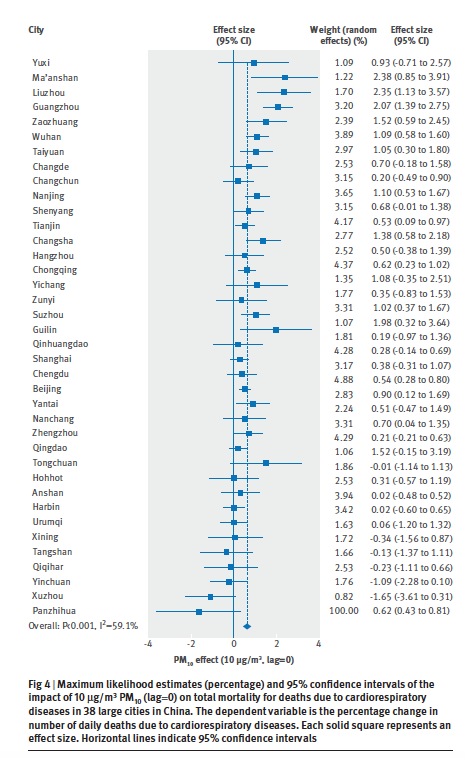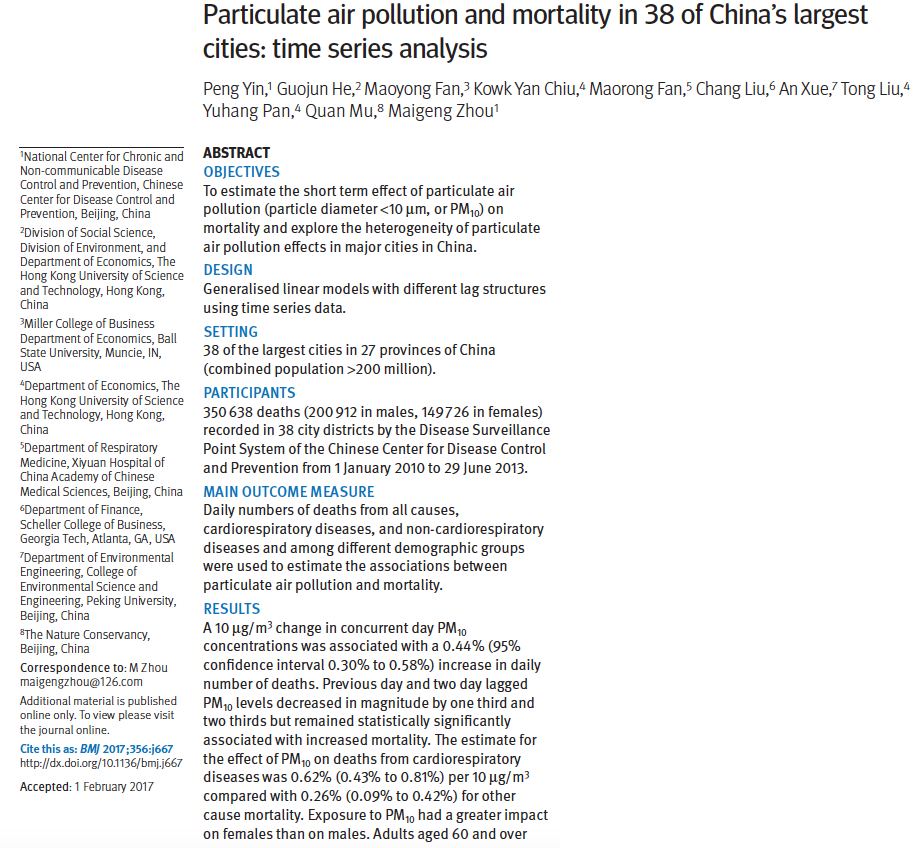False. Air pollution kills no one in China. China should clean its filthy air, but no lives will be saved. This new study is just more egregiously bad, self-debunking air quality junk science.

The media release and abstract are below. The study is here.
Moving past the (to name a few problems)…
- Cherry-picking (data from only certain districts in Chinese cities);
- No exposure data (no data on how much PM10 anyone was exposed to); and
- No data on confounding risk factors or PM2.5 exposures (I thought PM2.5 was the great killer and what about smoking? Half of Chinese men smoke.)
… the study killer here is this chart. Can you figure out why?

Just like the law of gravity holds true in each of the Chinese cities, if PM10 killed, it would kill everywhere from Guangzhou to Panzhihua. But this is not the case. In many of the Chinese cities, the effect size and 95% confidence intervals cross into zero and/or negative territory. Why would PM10 kill in Guangzhou, but have almost a protective effect in Panzhihua? Can’t answer that? Neither can I. The Chinese answer to that was just to combine all their results in a weighted approach and hope to come up with a positive number. They may have got their (teeny-tiny) positive number but it is, of course, meaningless given the paradox and all the uncertainty in their data.
You can read the crappy study if you want, but a better read would be my new book, “Scare Pollution: Why and How to Fix the EPA” — the definitive guide to debunking the claim that air pollution kills.
###
Better air quality standards in China could save 3 million early deaths each year
BMJ
Adopting and enforcing tighter air quality standards in China could save 3 million premature deaths each year and may bring about tremendous public health benefits, say experts in The BMJ today.
Researchers led by Maigeng Zhou at the Chinese Center for Disease Control and Prevention in Beijing, predicted the short term effects of particulate air pollution (particle diameter less than 10 μm, PM10) on mortality in 38 of China’s largest cities from 1 January 2010 to 29 June 2013 (combined population of more than 200 million).
Over the study period, the daily mean of PM10 concentrations across all locations was 92.9 μg/m3.
The most polluted city in the sample was Urumqi in Xinjiang Province, with an average daily mean PM10 concentration of 136.0 μg/m3. The least polluted city was Qinhuangdao in Hebei Province, with an average daily mean PM10 concentration of 66.9 μg/m3.
Over 350,000 deaths were recorded during the study period. Although PM10 mortality associations varied substantially across different cities, the researchers found positive associations between daily mortality and exposure to PM10 in most (87%) of sampled cities.
On closer examination, they found that air pollution appeared to have a much greater impact on deaths due to cardiorespiratory diseases, such as asthma and chronic lung disease (COPD), than it did on deaths due to other causes.
They also found that the potential impact of PM10 pollution was greater for females than males; and that air pollution may primarily affect people aged 60 years or more.
This study involved modelled data which can make predictions about cause and effect, but cannot be used to draw firm causal conclusions. Additionally, the authors warn that the potential short term effects of particulate air pollution are city specific, and therefore estimates obtained from one city should not be generalised to all cities.
However, they suggest that bringing China’s PM10 level to the WHO standard of 20 μg/m3 would save 3 million premature deaths each year.
They add that this number is likely to be a lower estimate of the total number of deaths related to air pollution because the air pollution effect can be larger in rural areas and PM10 is more detrimental to human health in the long run.
“Our findings suggest that adopting and enforcing tighter air quality standards in China will bring about tremendous public health benefits,” they conclude.
###

I recall these comments from Freeman Dyson – from the 2009 piece, “The Civil Heretic.”
For Hansen, the dark agent of the looming environmental apocalypse is carbon dioxide contained in coal smoke. Coal, he has written, “is the single greatest threat to civilization and all life on our planet.” Hansen has referred to railroad cars transporting coal as “death trains.” Dyson, on the other hand, told me in conversations and e-mail messages that “Jim Hansen’s crusade against coal overstates the harm carbon dioxide can do.” Dyson well remembers the lethal black London coal fog of his youth when, after a day of visiting the city, he would return to his hometown of Winchester with his white shirt collar turned black. Coal, Dyson says, contains “real pollutants” like soot, sulphur and nitrogen oxides, “really nasty stuff that makes people sick and looks ugly.” These are “rightly considered a moral evil,” he says, but they “can be reduced to low levels by scrubbers at an affordable cost.” He says Hansen “exploits” the toxic elements of burning coal as a way of condemning the carbon dioxide it releases, “which cannot be reduced at an affordable cost, but does not do any substantial harm.”
We’ve got to clean up the air – but drop the nonsense about CO2 being the evil molecule.
that’s over 8,000 a day! you would think someone would have noticed that many people falling over dead from air pollution EVERY DAY.